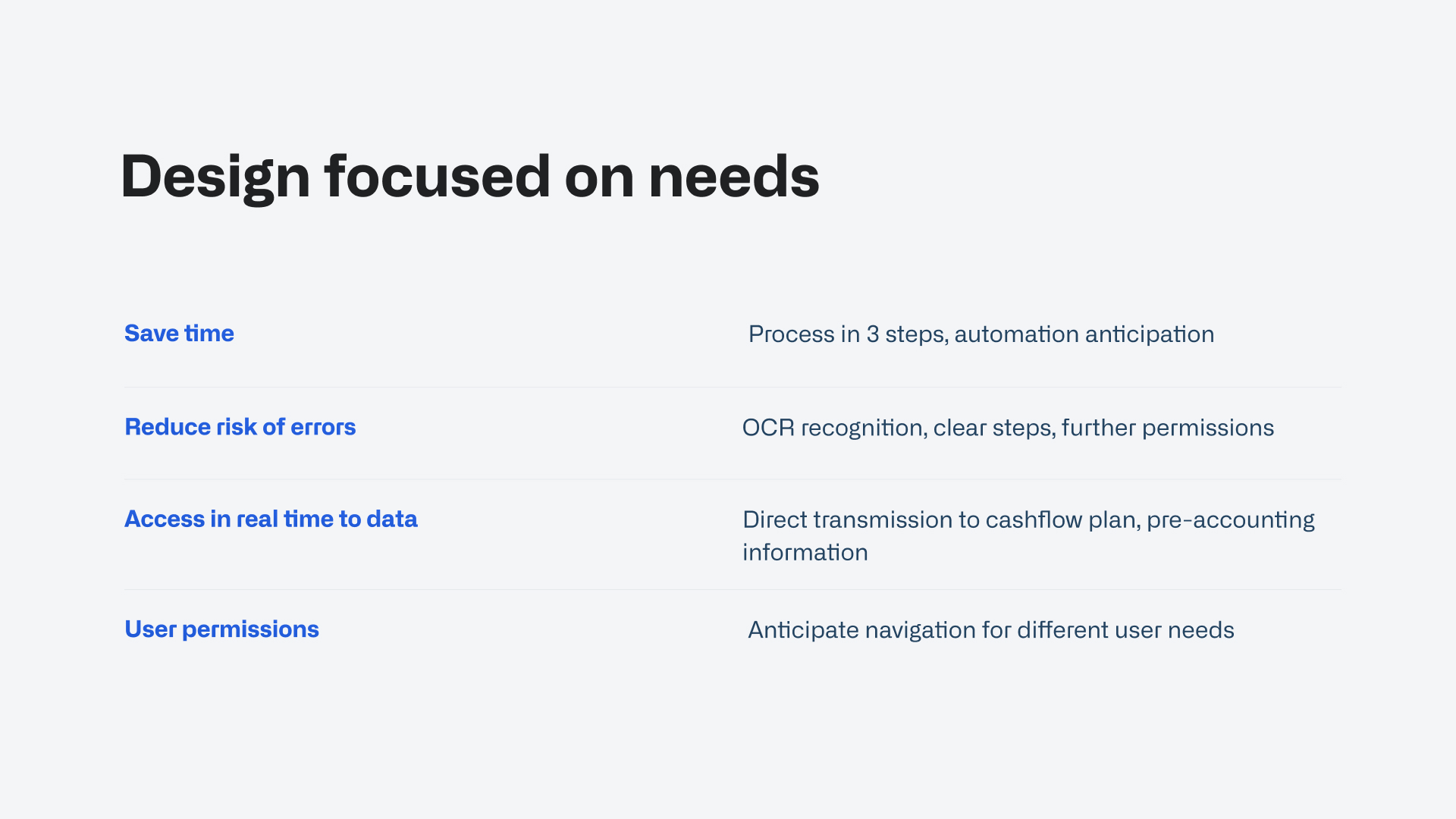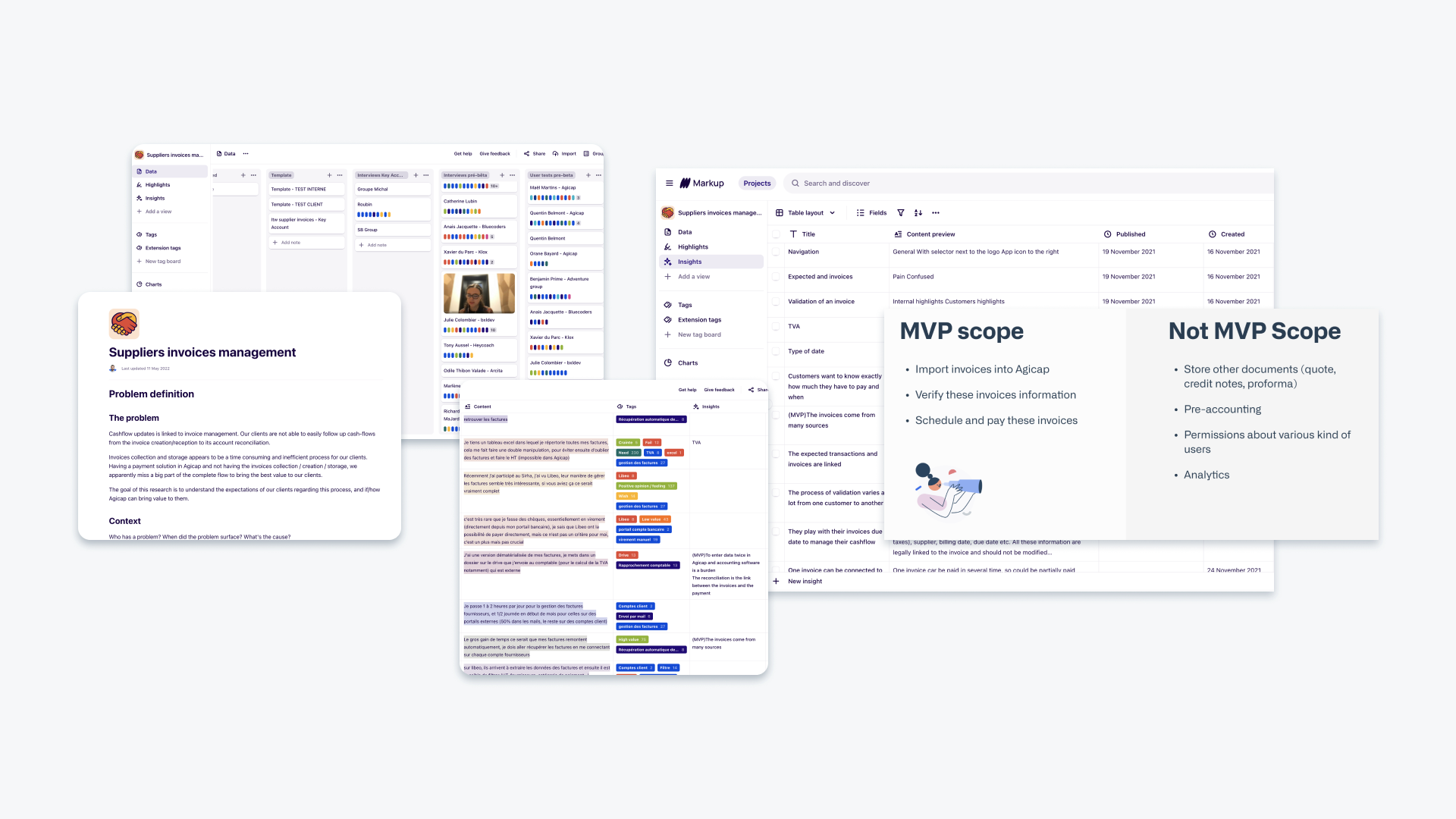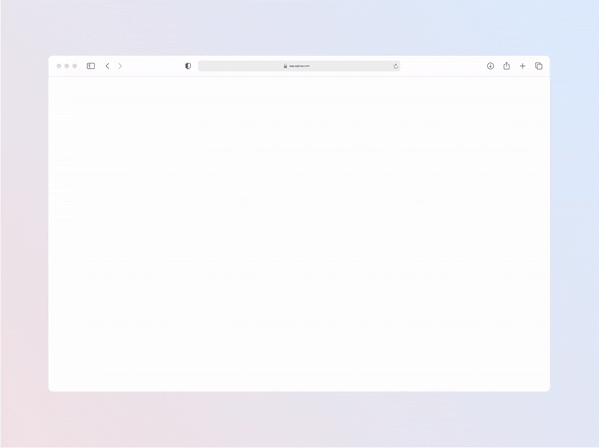
The main problem was that our users used a variety of products to manage different parts of their supplier management process. A software to pay, a software to manage their invoices, another software to settle their accounting and finally Agicap to optimize their financial projections.
We needed to develop a solution that could be easily interfaced with other parts of the supplier invoice management process.

User research
Here are the user research steps we have led in order to learn more on how our users are managing their supplier invoices, from understanding their processes and identifying their needs. Finally, the user tests allowed us to validate what would be our MVP solution to launch.

User research learnings:
1. Mandatory tasks do not add value to the business → time-consuming.
2. Documents filled in manually → increases the risk of errors.
3. Several tools used → multiplication of information → difficulties to gather information.
4. Different users are involved in the all process → any mistake have consequences.
Based on this needs, we prioritized the MVP solution we wanted to offer to our users.

Based on the Agicap design system, I built mock-ups and we tested them directly with users. We conducted our user tests to verify that we were adding enough value with the first MVP version we had imagined. So I made a prototype on Figma, to be tested with real users.

What actions came from our user tests?
Navigation between invoices and their payments is crucial => we needed to improve our navigation process. That is how a navigation revamp in Agicap began (an other topic I worked on).
This also allowed us to prioritize the following features we had to develop in order to bring more value to our users : pre-accounting and reconciliation features.

MVP scope
User tests allowed to validate what would be the minimum viable product our users would be agree to use. This was composed of few mandatory elements:
- Information validation process
- Payment information updates
- Invoice storage


From mockups to development
Alignment with the dev team?
We invited some developers to visualize user tests in order to let them anticipate the solution and understand the user point of vue. This helped us align ourselves. With the Product Manager, we scinded the MVP into features and user stories, and translated the mockups into develoment specs. I also worked strongly with the front developer in order to work together on the best interface possible.
Design critic and design system
From my first wireframes, I regularly undertook to show my work during our team design critics, in order improve mockups thanks to their feedbacks.
I used Agicap design system (called Flipper), in order to keep consistency with the core product of Agicap. I also had to build new components or assets in order to answer new user needs for this project. This was the case for the Invoice modal, the empty-states illustrations, the invoices sidepanels.

MVP launch
How to measure the solution success?
We prepared a data board in order to anticipate and measure what would be the success of this new solution.
Some Key metrics of this solutions:
-
DAU - WAU - MAU (Daily, Weekly or Monthly Active Users)
- Use of the main features
- Number of Invoices imported then verified into our solution

Business understanding
We launched the solution that brang the best business value as possible for our users and for Agicap. With the PMM (Product Marketing Manager) we worked on the value proposition for our users, and help our sales present this new service.
Our value proposition key points:
-
Save time: more than 70% saved
-
Increase visibility: better control of future outflows of your invoices
-
Improve relationship with key suppliers: by a better invoice management
-
Reduce costs to manage invoices: from 11€ to 3€
-
Reduce error risks: thanks to the OCR that extracts informations
-
Access in real time to financial data: directly updated in your cashflow plan
Beta-testers
We first activated the solution for beta-test users, who were the users that answered to our user research surveys and interviews and that confirm their interests. They were able to use the feature for free at the beginning and had access to a feedback banner to share their feedbacks directly to us. That helped us to build our improvment roadmap.
Once we were reassured that the feature had enough value and satifcation, we launched it into market for all our users.
Design principles
The design principles that I have reinforced through this project?
We had to be very pragmatic in integrating this MVP solution into Agicap. Indeed, the idea was to prove its success with real users and to build its evolution thanks to their feedback. From a design point of view, I had to understand the business and technical point of view while defending the best possible user experience. This wasn't always easy, but as a team we successfully managed to find compromises that allowed the product, technology and view design to evolve.
-
Be pragmatic (MVP scope)
- Build with users
- Anticipate complexity but always try to simplify
-
Ask for feedbacks at each step
- Keep consistency within the entire product experience
---

